
Here is a fun fall star hop to several great deep sky objects, heading south from the tail of the whale, namely, the west end of constellation Cetus. The targets include a Halloween themed planetary nebula, an off the beaten path globular cluster, a famed bright spiral galaxy, a large tenuously dim spiral galaxy, and short hop to a deep sky challenge chain of four dim galaxies.
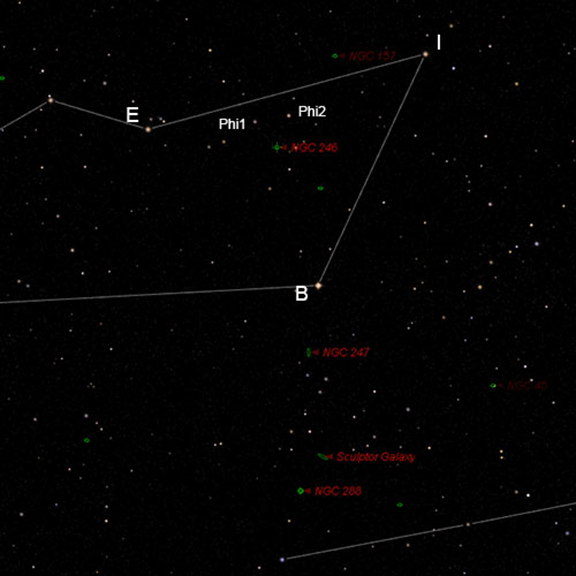
Start by finding the stars (E) Eta and (I) Iota Ceti, above the constellations' (B) Beta star Diphda, split the distance between E and I and drop south 2-1/2 degree through stars Phi1 and Phi2 Ceti.
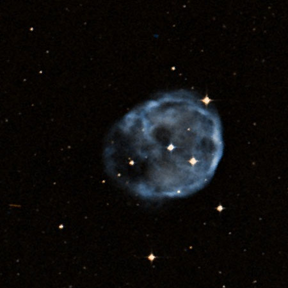 You are in the environs of planetary nebula NGC 246, known as the Skull Nebula. Dim and large at 240x210 arc-seconds, it is visible in an 80mm finder. But in the eyepiece with an Ultrablock filter, details emerge. At 160X magnification one edge appears brighter, and stars superimposed over the annularity give a 3D appearance. Easy to find, it is a favorite you'll return to each October! And it provides a spectacular start to our journey.
You are in the environs of planetary nebula NGC 246, known as the Skull Nebula. Dim and large at 240x210 arc-seconds, it is visible in an 80mm finder. But in the eyepiece with an Ultrablock filter, details emerge. At 160X magnification one edge appears brighter, and stars superimposed over the annularity give a 3D appearance. Easy to find, it is a favorite you'll return to each October! And it provides a spectacular start to our journey.
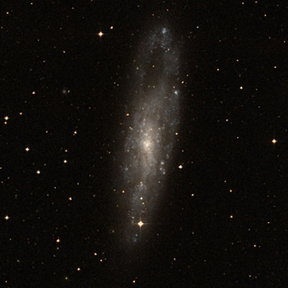 Drop south of (B) Diphda three degrees, and search your low power eyepiece field of view for the large but dim member of the Sculptor Group, NGC 247, an odd spiral galaxy with a notable void in its extended arms. With a major axis of 21.4' and minor axis at 6.9', you'll find its visual magnitude of 9.1 surprisingly challenging, and indeed its surface brightness is a paltry 14.4. Even more surprising is the relative closeness of the object, only 11.1 million light years! In an 8" telescope expert observer Steve Gottlieb's notes describe it as "very large, elongated ~N-S, bright core. A mag 10 star is at the south tip. The southern extension appears brighter" and in 13.1" as "fairly bright, diffuse, very large, bright core." What do you see?
Drop south of (B) Diphda three degrees, and search your low power eyepiece field of view for the large but dim member of the Sculptor Group, NGC 247, an odd spiral galaxy with a notable void in its extended arms. With a major axis of 21.4' and minor axis at 6.9', you'll find its visual magnitude of 9.1 surprisingly challenging, and indeed its surface brightness is a paltry 14.4. Even more surprising is the relative closeness of the object, only 11.1 million light years! In an 8" telescope expert observer Steve Gottlieb's notes describe it as "very large, elongated ~N-S, bright core. A mag 10 star is at the south tip. The southern extension appears brighter" and in 13.1" as "fairly bright, diffuse, very large, bright core." What do you see?
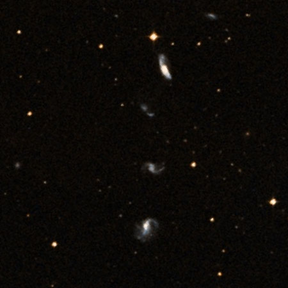 While you are on NGC 247, you might challenge yourself with a small chain of galaxies dubbed "Burbidge's Chain, 18' to the NNE. You will need dark transparent skies, and a large telescope, as these are listed with blue magnitudes as: PGC 2791 (14.4), PGC 2494 (17.0), NGC 2496 (15.0) and NGC 2497 (18.0) ? although their small sizes give higher surface brightnesses. Can you check off any of these dim bits of the cosmos?
While you are on NGC 247, you might challenge yourself with a small chain of galaxies dubbed "Burbidge's Chain, 18' to the NNE. You will need dark transparent skies, and a large telescope, as these are listed with blue magnitudes as: PGC 2791 (14.4), PGC 2494 (17.0), NGC 2496 (15.0) and NGC 2497 (18.0) ? although their small sizes give higher surface brightnesses. Can you check off any of these dim bits of the cosmos?
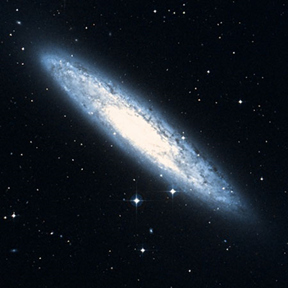 If the chain was a pain, you're now in for a treat! NGC 253 is colloquially known as the Silver Dollar Galaxy, and certainly as the Sculptor Galaxy (and gravitational behemoth of the Sculptor Group including the aforementioned NGC 247. This is such a bright piece of eye candy, had it been a few degrees further north it would certainly have a Messier designation. Covering and area 27.5'x6.8' it is a bit wider than NGC 247's 21.4', but its magnitude of 7.1 gives a surface brightness of 12.7. Even that surface brightness does not do justice to the view. It in a 13" telescope Gottlieb very accurately writes "very bright, elongated 4:1 SW-NE, very mottled, dust lanes, dark patches, 30' diameter." Discovered by Herschel, but this time Caroline, this is a top ten galaxy, spectacular from southern latitudes!
If the chain was a pain, you're now in for a treat! NGC 253 is colloquially known as the Silver Dollar Galaxy, and certainly as the Sculptor Galaxy (and gravitational behemoth of the Sculptor Group including the aforementioned NGC 247. This is such a bright piece of eye candy, had it been a few degrees further north it would certainly have a Messier designation. Covering and area 27.5'x6.8' it is a bit wider than NGC 247's 21.4', but its magnitude of 7.1 gives a surface brightness of 12.7. Even that surface brightness does not do justice to the view. It in a 13" telescope Gottlieb very accurately writes "very bright, elongated 4:1 SW-NE, very mottled, dust lanes, dark patches, 30' diameter." Discovered by Herschel, but this time Caroline, this is a top ten galaxy, spectacular from southern latitudes!
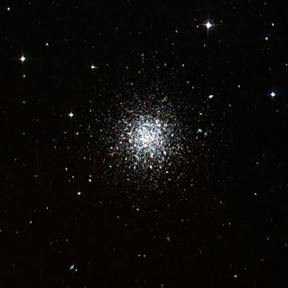 Finally, let's visit a fine southern globular cluster just south of the Silver Dollar, NGC 288. Move two degrees south-southwest and this target will jump into view at magnitude 8.1 and relatively large size of 13.1', and with an interesting galactic latitude of -89.4, nearly at the galactic southern pole. Viewed in an 8" telescope at 200X one may find faint stars revolved across the disc, many near visual limit (Gottlieb). While at low latitude in northern skies, it was described by William Herschel from South Africa as ?bright; large; round; gradually brighter in the middle; all resolved into stars."
Finally, let's visit a fine southern globular cluster just south of the Silver Dollar, NGC 288. Move two degrees south-southwest and this target will jump into view at magnitude 8.1 and relatively large size of 13.1', and with an interesting galactic latitude of -89.4, nearly at the galactic southern pole. Viewed in an 8" telescope at 200X one may find faint stars revolved across the disc, many near visual limit (Gottlieb). While at low latitude in northern skies, it was described by William Herschel from South Africa as ?bright; large; round; gradually brighter in the middle; all resolved into stars."
There's lots to see in the depths of Cetus and below. If you are curious enough, maybe you'll do some astro-travel and view more southern gems. Summer is approaching in the south!















